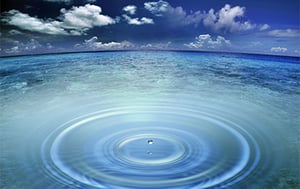Despite the recent, much-needed rains in the western part of our country, many areas have yet to fully recover from historic multi-year droughts. Partly as a result of these droughts, and also because of the growing awareness of sustainability, there’s increasing understanding that fresh water isn’t an infinite resource. It needs to be measured, managed, and conserved. Also, it’s important to understand water and energy are closely interconnected.
 A significant portion of our nation’s electric energy consumption is related to the treatment and distribution of water – anywhere from 3% to 13%, depending on how you calculate it. What’s more, the majority of our electrical generation requires water for cooling and other processes, meaning the energy necessary to provide us with reliable water requires the consumption of a significant amount of water. Stated another way: It takes energy to get water, and it takes water to make the energy to get water.
A significant portion of our nation’s electric energy consumption is related to the treatment and distribution of water – anywhere from 3% to 13%, depending on how you calculate it. What’s more, the majority of our electrical generation requires water for cooling and other processes, meaning the energy necessary to provide us with reliable water requires the consumption of a significant amount of water. Stated another way: It takes energy to get water, and it takes water to make the energy to get water.
This interdependency is called the water-energy nexus, and many fine reports have been produced to inform policy makers of the challenges we’re likely to face in the coming decades.
Comparing Water & Energy Usage
A good way to explore the interrelationship and the regional differences in intensity factors is to look at a single building in different areas of the country. Shown below are electricity and water usage for a 60,000 SF Class A office building. The first set of charts is with the building located in Richmond, Virginia. The next set shows the same building in North Carolina.

In Virginia, energy and water are relatively cheap and water-energy intensity factors are relatively low (kWh/gallon for water treatment, and gallon/kWh for power production). Even so, the figures associate significantly more electricity and water with the building than the meter would otherwise indicate.

In North Carolina, the amount of water consumed in the production of electricity is an order of magnitude higher, so significantly more water is associated with the building’s power usage even though the climate is similar and the billed kWh are roughly the same. The energy use associated with treating and moving water is also higher.
While 2%, or even 9% of additional electricity use for a building might not sound like a big deal, it can add up to a staggering amount. Using the conservative value of 3% of total U.S. electricity production mentioned at the beginning of this post, the amount of electricity consumed in water production is equal to the annual output of about 40 coal-fired power plants. The water consumed in electricity generation might also seem minimal, but several states are water constrained and many are experiencing conflicts over water allocation among power, agriculture, manufacturing, and municipal water providers.
Understanding the Water-Energy Relationship
There’s clearly a lot more to this topic than presented here. I’ve intentionally left off the important subjects of energy conversion and associated greenhouse gas emissions. Even addressing these subjects wouldn’t cover everything since more water and energy is involved in the extraction, refinement, and distribution of fuel used to produce most of our energy. However, I hope it’s clear saving water can have a positive ripple effect on energy and emissions, and saving energy will have a similar beneficial result for our water resources.
References
1. The Water-Energy Nexus: Challenges and Opportunities. US Department of Energy, June 2014.
2. Energy-Water Nexus: The Water Sector’s Energy Use; Claudia Copeland, January 3, 2014.
Image courtesy of technosamrat.com


